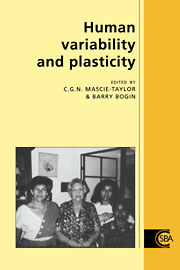Book contents
- Frontmatter
- Contents
- List of contributors
- Foreword
- 1 The pervasiveness of plasticity
- 2 Plasticity in early development
- 3 Plasticity in the growth of Mayan refugee children living in the United States
- 4 The place of plasticity in the study of the secular trend for male stature: an analysis of Danish biological population history
- 5 Plasticity, growth and energy balance
- 6 The study of migrants as a strategy for understanding human biological plasticity
- 7 Human migration: effects on people, effects on populations
- 8 The use of surnames in the study of human variation and plasticity
- 9 A biological anthropological approach to measuring societal stress of parasitic disease: a case study of schistosomiasis
- 10 Biological adaptability, plasticity and disease: patterns in modernizing societies
- 11 Human biological adaptability with special emphasis on plasticity: history, development and problems for future research
- Index
1 - The pervasiveness of plasticity
Published online by Cambridge University Press: 28 October 2009
- Frontmatter
- Contents
- List of contributors
- Foreword
- 1 The pervasiveness of plasticity
- 2 Plasticity in early development
- 3 Plasticity in the growth of Mayan refugee children living in the United States
- 4 The place of plasticity in the study of the secular trend for male stature: an analysis of Danish biological population history
- 5 Plasticity, growth and energy balance
- 6 The study of migrants as a strategy for understanding human biological plasticity
- 7 Human migration: effects on people, effects on populations
- 8 The use of surnames in the study of human variation and plasticity
- 9 A biological anthropological approach to measuring societal stress of parasitic disease: a case study of schistosomiasis
- 10 Biological adaptability, plasticity and disease: patterns in modernizing societies
- 11 Human biological adaptability with special emphasis on plasticity: history, development and problems for future research
- Index
Summary
Summary
It is shown that plasticity is one of the key concepts in human biology; it provides a link between the widely differing areas of the subject in which it is manifested, and so gives a unity of approach and understanding that holds the subject together. Earlier studies tended to be empirical, concerned mainly with body size and form. Knowledge was refined by experimental studies, some exploiting ‘natural experiments’, situations that have occurred without scientific planning; some monitoring the effects of changes introduced for purposes other than experiment; others examining the effects of chosen variables in planned experimental situations. It is this last type of study that has helped us to understand the mechanisms of the plasticity response. As a result, the pervasiveness of plasticity is now apparent, its effects being discernible in features ranging from gross variables such as body size down to details of body composition and the distribution and structure of tissues. It occurs not only during the growing period but also in adulthood and senescence. The occurrence of plasticity brought about by functional adaptation of the individual, supported by genetic experiment, suggests an evolutionary process additional to natural selection by which organisms achieve long-term adaptation to their environments.
Introduction
‘Plasticity’ derives from the family of Greek words with the root plassu, e.g. plasticos, and is defined in the Oxford English Dictionary as ‘the capability of being moulded’.
I first came across the word applied in biology by Huxley (1942), who used it with several connotations. It denoted: …
- Type
- Chapter
- Information
- Human Variability and Plasticity , pp. 1 - 17Publisher: Cambridge University PressPrint publication year: 1995
- 7
- Cited by



